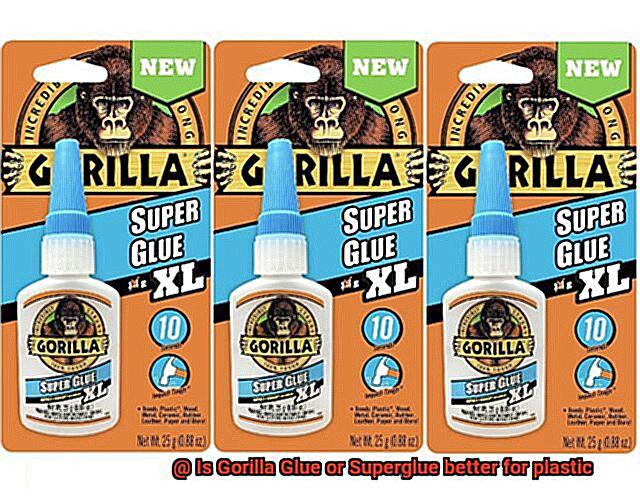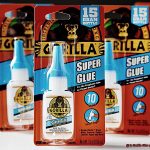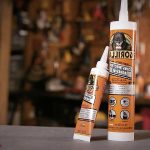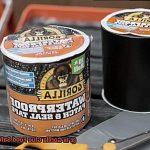Welcome to our blog, where we’re about to tackle a sticky situation: Gorilla Glue or Superglue for plastic?
You know the drill – when you’re faced with a broken plastic piece, finding the right adhesive is key. But which one reigns supreme?
It’s time to dive into the nitty-gritty of these popular glues and uncover their strengths and weaknesses. We’ll break it down so you can make an informed decision next time you’re in need of some bonding magic.
So whether you’re a DIY guru or just dabble in fixing stuff, let’s embark on this adhesive adventure and discover the ultimate plastic bonding solution.
Overview of Gorilla Glue
Contents
When it comes to finding a reliable adhesive that can bond various materials, including plastic, Gorilla Glue stands out as a top contender. Renowned for its exceptional strength and versatility, this polyurethane-based adhesive has gained popularity among DIY enthusiasts and professionals alike. Join us as we dive into the remarkable characteristics, diverse uses, and comparisons of Gorilla Glue, uncovering why it has become the go-to choice for countless bonding projects.
Characteristics:
- Strength: Gorilla Glue truly lives up to its name, providing an incredibly strong bond that can withstand high impact and temperature changes. It excels in both indoor and outdoor applications.
- Waterproof: With its waterproof properties, Gorilla Glue guarantees durability even in wet environments or when exposed to moisture. No more worrying about your glued items falling apart during rainy days.
- Expanding Formula: As the glue dries, it expands to fill gaps and create an ironclad bond. This unique feature makes Gorilla Glue perfect for filling cracks or reinforcing weakened areas, ensuring your project remains sturdy and reliable.
- Curing Time: Gorilla Glue is no slouch when it comes to curing time. It dries within 24 hours and reaches its maximum strength within 72 hours, granting you ample time to position and adjust your project before the bond sets.
Uses:
- Plastic Repair: Gorilla Glue shines in repairing broken plastic items such as toys, household appliances, and automotive parts. Its ability to bond different types of plastic, including ABS, PVC, acrylic, and polycarbonate, makes it a versatile solution for tackling various repair jobs.
- General DIY Projects: Whether you’re working on woodworking, metalworking, ceramics, or other craft projects, Gorilla Glue provides a strong bond across a wide range of materials. From fixing furniture to assembling intricate sculptures, this adhesive is a trusty companion in all your creative endeavors.
- Indoor and Outdoor Applications: Thanks to its exceptional waterproof properties, Gorilla Glue is equally suitable for both interior and exterior use. Secure decorative elements indoors or fix outdoor furniture without worrying about the glue breaking down under different environmental conditions.
Comparison with Superglue:
While Gorilla Glue and Superglue are both effective adhesives for bonding plastic, understanding their differences is crucial for choosing the right one for your project.
- Gorilla Glue: Recommended for larger plastic surfaces or applications that require a strong and long-lasting bond. It excels in heavy-duty projects where durability is paramount.
- Superglue: Ideal for small repairs or bonding lightweight plastic parts that require an instant bond. It is commonly used for quick fixes, providing a rapid and reliable solution.
Superglue
Superglue, the superhero of adhesives, is the ultimate solution for quick fixes and strong bonds. Also known as cyanoacrylate adhesive, this miraculous adhesive was discovered by Dr. Harry Coover in the 1940s while researching materials for clear plastic gun sights during World War II. Little did he know that his accidental discovery would become a household name.
What makes Superglue so super? It’s all in the formula. Made from a combination of cyanoacrylate monomers, it rapidly polymerizes upon exposure to moisture. This means that as soon as you apply it to a surface, it starts forming powerful chemical bonds that create a durable and permanent connection.
Superglue is like a chameleon – it can bond with almost any material you throw at it. Metal? No problem. Glass? Piece of cake. Ceramics? Easy peasy. Most plastics? Absolutely. However, it’s important to note that different types of plastics may require different approaches for successful bonding. While some plastics have low surface energy or contain additives that hinder bonding, many types – such as polystyrene and acrylics – can be successfully bonded using Superglue.
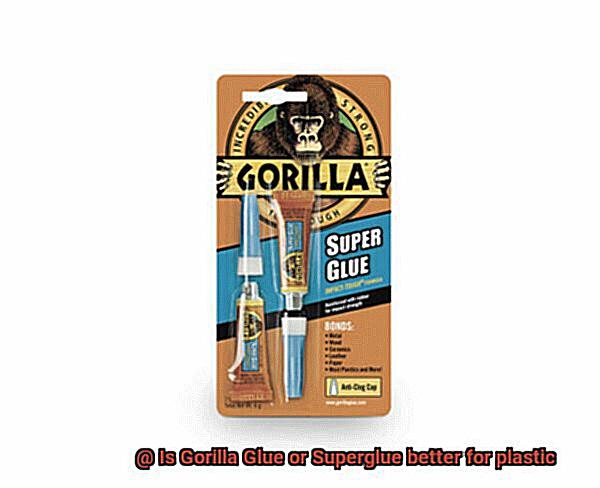
One of Superglue’s most impressive features is its lightning-fast drying time. Within seconds of application, you’ll have a bond that can withstand considerable stress once fully cured. And speaking of curing, Superglue is resistant to water and most chemicals, making it suitable for a wide range of applications.
Applying Superglue is as easy as pie. Just ensure the surfaces you’re bonding are clean and free from oils or contaminants that might interfere with the process. Then, apply a small amount of glue evenly across the surfaces and hold them together firmly until the glue sets. Voila. You’ve got yourself a strong bond.
But remember, with great power comes great responsibility. While Superglue is generally safe to use, take precautions to avoid skin contact and inhalation of fumes. Use it in a well-ventilated area and consider wearing protective gloves when handling the adhesive.
Gorilla Glue vs Superglue for Plastic Bonding
When it comes to bonding plastic materials, selecting the right adhesive is crucial for achieving a strong and durable connection. Two popular options on the market are Gorilla Glue and Superglue. While they share similarities, they also possess distinct properties that make them better suited for specific plastic bonding applications. In this article, we will compare the advantages and disadvantages of Gorilla Glue and Superglue to help you make an informed decision.
Gorilla Glue:
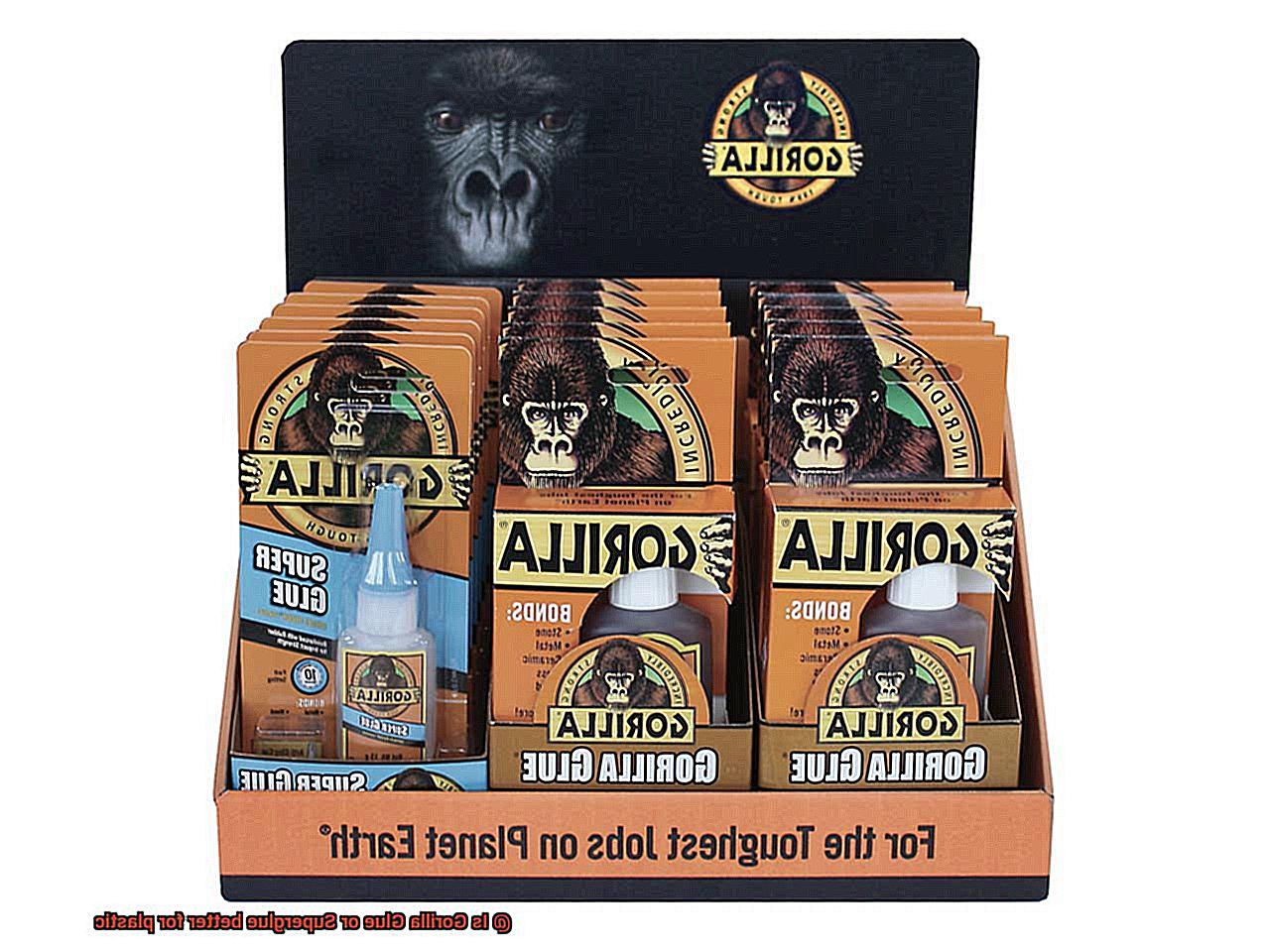
Advantages:
- Versatility: Gorilla Glue can bond a wide range of materials, including plastics, wood, metal, ceramics, and more. This makes it a versatile option for various projects.
- Gap-filling properties: The expanding nature of Gorilla Glue allows it to fill gaps and create strong bonds even on irregular or uneven plastic surfaces. This ensures a reliable connection even in challenging applications.
- Durability: Once cured, Gorilla Glue forms a strong and long-lasting bond, ensuring that your plastic bonding project remains intact for an extended period.
Disadvantages:
Application method: Gorilla Glue requires moisture to activate the curing process, so dampening the surfaces before application is necessary. Additionally, clamping or using weights may be required to ensure proper contact during the curing process.
Superglue:
Advantages:
- Fast-setting: Superglue forms an instant bond when exposed to moisture in the air, making it ideal for quick repairs or bonding small plastic parts that need immediate strength.
- Precise connections: Superglue is well-suited for bonding smooth and flat plastic surfaces, creating tight connections that are critical when precision is necessary.
- Ease of application: Superglue can be applied directly to the plastic parts without the need for additional steps, simplifying the bonding process.
Disadvantages:
- Limited material compatibility: Superglue is best for bonding specific types of plastics like polystyrene and polycarbonate. It may not provide optimal results when used on other plastic materials.
- Lack of gap-filling properties: Unlike Gorilla Glue, Superglue does not fill gaps or voids in the bond. This makes it less suitable for applications with uneven or irregular plastic surfaces.
Different Types of Plastics and Their Adhesion Needs
Did you know that not all plastics are created equal? It’s true. Each type of plastic has its own distinct personality when it comes to sticking them together. Some plastics have a rebellious low surface energy, making it a challenge for adhesives to bond to them. Others possess high chemical resistance, demanding the use of specialized adhesives. Let’s take a deep dive into the intriguing world of plastics and their unique adhesion needs.
Heading 2: Polyethylene (PE) – Slippery and Enigmatic.
Polyethylene, commonly found in packaging materials and plastic bags, is a true enigma when it comes to adhesion. Its low surface energy poses quite a challenge for regular glues. But fear not, for there are special adhesives designed exclusively for PE or other low surface energy materials. So, if you find yourself trying to mend that torn plastic bag, be sure to wield the right adhesive like a pro.
Heading 3: Polypropylene (PP) – A Slippery Nut to Crack
Polypropylene, the cousin of PE, is encountered in automotive parts and food containers. However, this slippery material also boasts a low surface energy, making it a tough nut to crack in terms of adhesion. Fear not though. There are certain adhesives available that can handle its elusive nature. Look out for polypropylene adhesives or cyanoacrylate adhesives with primers to achieve the strong bond you desire.
Heading 4: Polystyrene (PS) – A Versatile Companion
Polystyrene is the jack-of-all-trades among plastics. From packaging materials to disposable cutlery, it can do it all. The good news is that PS has a smooth surface and moderate surface energy, allowing many types of glues to work their magic. So grab some super glue or epoxy, and you’ll be sticking things to PS like a seasoned pro.
Heading 5: Polyvinyl Chloride (PVC) – Strong and Adaptable
PVC is undeniably a superstar in the realm of plastics. Its applications span across construction, plumbing, and electrical fields. The best part? PVC boasts high surface energy, granting you a plethora of adhesive options. Whether you opt for PVC pipe cement or epoxy-based adhesives, rest assured that you’ll achieve a bond of unwavering strength.
Preparing the Surface for Bonding
Achieving a strong and long-lasting bond between plastic and glue requires careful surface preparation. By following these steps, you can become a surface prep pro and ensure optimal bonding performance.
- Clean the surface: Begin by ensuring that the surface is squeaky clean. No dirt, oil, or debris should be present. Use a mild detergent or soap and scrub the plastic with a soft cloth or sponge. Pay extra attention to the areas that will be bonded together. We want them spick and span.
- Remove oil and grease: Banish any traces of oil or grease that can sabotage our bonding efforts. Rubbing alcohol or acetone can be used to wipe away oily residue. Apply a small amount of solvent onto a clean cloth and gently wipe the surface. Be cautious not to damage the plastic.
- Roughen the surface: Now it’s time to rough things up in a good way. Use fine-grit sandpaper to create a rougher texture on the surface. Gently sand in circular motions to enhance the adhesive’s grip on the plastic. Avoid excessive sanding that could damage the plastic.
- Clear away debris: After sanding, it’s crucial to get rid of any dust or debris that may have accumulated. Use a clean, dry cloth or compressed air to remove those pesky particles. A clean surface is essential for maximum bonding potential.
- Primer (if needed): In some cases, priming may be necessary, especially when dealing with smooth or non-porous plastics. Primers are specially formulated products that improve adhesion on tricky surfaces. Choose a primer compatible with both the plastic and glue being used. Follow the manufacturer’s instructions carefully, apply the primer, and let it dry completely before applying the glue.
Specialized Formulations for Plastic Bonding
Specialized formulations for plastic bonding offer a world of possibilities when it comes to creating strong and durable bonds on plastic materials. These adhesives are like the superheroes of the adhesive world, each with their own unique superpowers. Let’s dive into some popular options and explore their characteristics.
One classic choice is cyanoacrylate, commonly known as superglue. This fast-curing adhesive provides excellent bonding strength on various types of plastics. It’s like the Flash of the adhesive world, swooping in to create quick and strong bonds.
Epoxy is another popular option for plastic bonding. It consists of two components that need to be mixed together before application. Once mixed, epoxy offers high strength and versatility in bonding different types of plastics. It’s like the Iron Man of adhesives, ready to tackle even the most complicated plastic projects.
But the fun doesn’t stop there. There are specialized formulations that cater to specific requirements in different industries. Some adhesives are formulated with flexibility in mind, allowing them to bend and stretch with the plastic without losing their grip. Others are resistant to chemicals or UV exposure, making them perfect for outdoor applications or industries like automotive or electronics.
When it comes to choosing between Gorilla Glue and Superglue for plastic bonding, it’s important to consider the specific properties required for your project. Gorilla Glue offers a wide range of adhesive products, including those specifically formulated for plastic bonding. Their Clear Grip and Super Glue Gel formulas are particularly popular for plastic applications. On the other hand, Superglue refers to cyanoacrylate adhesives in general and is widely available from various brands.
To make the right choice, consider factors like the type of plastic being bonded, the desired cure time, the level of flexibility needed, and any additional properties required for your application. Read the product labels and instructions carefully to ensure that the chosen adhesive is suitable for your specific type of plastic. And if you’re feeling unsure, it’s always a good idea to test the adhesive on a small, inconspicuous area before committing to the entire project.
Factors to Consider When Choosing an Adhesive
Choosing the right adhesive for your project is crucial for achieving a successful bond. Consider the following factors when selecting an adhesive:
- Type of Material: Different adhesives are formulated to bond specific materials. Consider the type of materials you are working with, such as plastic, wood, metal, or fabric, and choose an adhesive that is compatible with those materials.
- Strength and Durability: Determine the strength and durability requirements for your project. If you need a strong bond that can withstand heavy loads or extreme conditions, look for adhesives that are known for their strength and durability. Consider factors such as tensile strength, shear strength, and resistance to temperature fluctuations.
- Application Method: Think about how you prefer to apply the adhesive. Some adhesives come in liquid form and require precise application using a brush or syringe, while others come in the form of tapes or pre-cut adhesive sheets, which can be easier to apply and provide consistent results. Choose an adhesive that suits your preferred application method.
- Drying Time: Consider the drying time of the adhesive. If you’re working on a time-sensitive project or need to move on to the next steps quickly, choose an adhesive that sets quickly. However, keep in mind that longer drying times often result in stronger bonds, so consider your priorities accordingly.
- Chemical Compatibility: If the bonded materials will be exposed to chemicals or solvents, it’s crucial to choose an adhesive that is chemically compatible. Some adhesives may break down or weaken when exposed to certain chemicals, compromising the strength of the bond. Look for adhesives that are known for their resistance to water and chemicals.
- Safety Considerations: Always prioritize safety when working with adhesives. Consider factors such as toxicity, fumes, and flammability. Some adhesives contain chemicals that can be harmful if ingested or come into contact with the skin or eyes. Make sure to use proper ventilation and take necessary protective measures.
- Environmental Factors: Consider the environmental conditions the adhesive will be exposed to. Will it be subjected to high humidity, UV radiation, or extreme temperatures? Choose an adhesive that is suitable for the specific environmental conditions to ensure the longevity of the bond.
- Cure Time: Some adhesives require a curing process to achieve their full strength. Consider the cure time required for the adhesive you are considering and determine if it aligns with your project timeline.
- Also Read: Does Gorilla Glue Work on Plastic?
Conclusion
In conclusion, when it comes to the battle of Gorilla Glue versus Superglue for plastic, Gorilla Glue emerges as the superior choice.
Its unmatched strength and durability make it the go-to adhesive for all your plastic bonding needs. Whether you’re repairing a broken toy or assembling a DIY project, Gorilla Glue will provide a reliable and long-lasting bond that can withstand even the toughest conditions.
So, if you want peace of mind and an adhesive that truly holds up, choose Gorilla Glue for all your plastic bonding endeavors.

